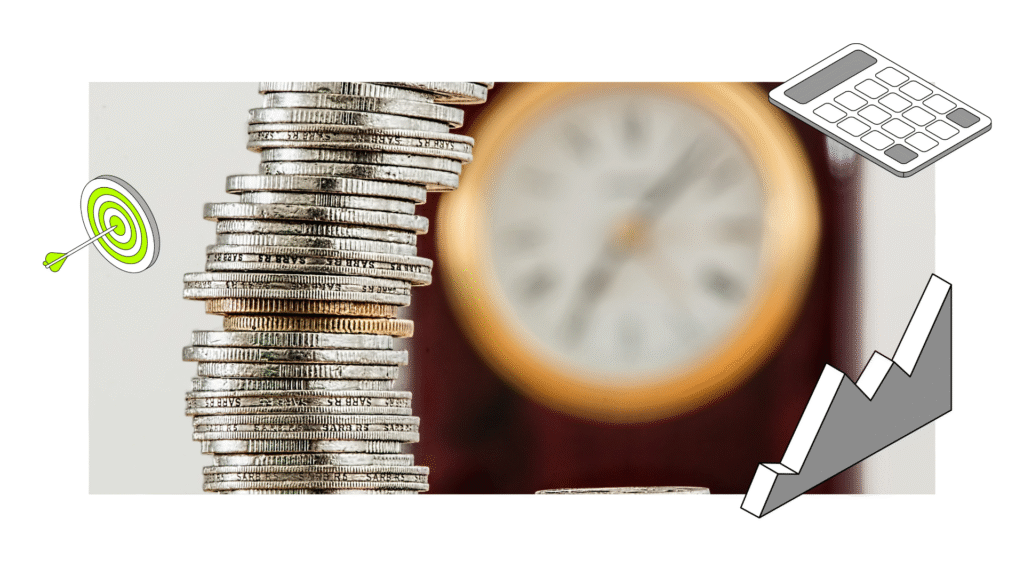The Impact of Inflation on Your Savings: What You Need to Know

Inflation is a term that frequently surfaces in economic discussions, but what does it really mean for your personal finances? As the cost of goods and services rises, the purchasing power of your money decreases. This can have a significant impact on your savings and overall financial health. In this blog post, we’ll explore how inflation affects your purchasing power and discuss strategies to protect your savings from its erosive effects. Understanding Inflation and Purchasing Power What is Inflation? Inflation refers to the rate at which the general level of prices for goods and services rises, resulting in a decrease in purchasing power. It’s typically measured by the Consumer Price Index (CPI), which tracks the price changes of a basket of consumer goods and services over time. A moderate level of inflation is considered a normal part of a growing economy, but high inflation can be detrimental to consumers. How Inflation Affects Purchasing Power When inflation rises, each dollar you own buys fewer goods and services than it did before. For example, if the inflation rate is 3% per year, something that costs $100 today will cost $103 a year from now. If your savings are not growing at a rate that outpaces inflation, you may find yourself in a situation where your money is worth less over time. Here’s a simple breakdown: Strategies to Protect Your Savings from Inflation Fortunately, there are several strategies you can employ to protect your savings from the negative impacts of inflation: 1. Invest in Stocks or Equity Funds Historically, the stock market has outpaced inflation over the long term. While stocks can be volatile in the short term, investing in a diversified portfolio of stocks or equity funds can provide growth potential that outstrips inflation. Consider low-cost index funds or exchange-traded funds (ETFs) that track the market. 2. Consider Real Estate Investments Real estate can act as a hedge against inflation. Property values and rental income tend to rise with inflation, making real estate a potentially lucrative investment. Whether you invest in rental properties or real estate investment trusts (REITs), this asset class can provide both income and appreciation. 3. Explore Inflation-Protected Securities Treasury Inflation-Protected Securities (TIPS) are a government-backed investment option designed to protect against inflation. The principal value of TIPS increases with inflation, ensuring that your investment grows in real terms. While the interest rates may be lower than other investments, the protection against inflation can be valuable. 4. Diversify Your Investments A diversified investment portfolio can help mitigate risks associated with inflation. By spreading your investments across various asset classes—such as stocks, bonds, real estate, and commodities—you can reduce the impact of inflation on your overall financial health. 5. Increase Your Savings Rate As inflation erodes your purchasing power, it becomes essential to increase your savings rate. Consider automating your savings contributions to ensure you consistently set aside money. Look for ways to cut unnecessary expenses and redirect those funds into savings or investments. 6. Utilize High-Yield Savings Accounts or CDs While traditional savings accounts often offer low-interest rates, high-yield savings accounts or certificates of deposit (CDs) can provide better returns. These accounts may offer interest rates that are more competitive, helping your savings grow even in an inflationary environment. 7. Stay Informed and Adjust Your Strategy Keep an eye on economic indicators and inflation trends. Being informed will allow you to adjust your financial strategy as necessary. If inflation is rising, you may want to shift your investments or savings tactics to better protect your purchasing power.
Retirement Planning for Millennials: Start Early for a Secure Future

As a millennial, you might feel like retirement is a distant concern. The truth is, the earlier you start planning for retirement, the more secure your future will be. While it may seem premature to think about retirement when you’re just starting your career, early planning can lead to significant financial benefits down the road. Here’s why you should prioritize retirement planning now and the various retirement accounts available to help you get started. Why Start Early? Types of Retirement Accounts Understanding the different retirement accounts available to you is crucial for effective planning. Here are some popular options: 1. 401(k) Plans Many employers offer 401(k) plans, which allow you to save for retirement through payroll deductions. Contributions are made pre-tax, reducing your taxable income for the year. Many employers also offer matching contributions, which is essentially free money. Aim to contribute enough to take full advantage of any employer match. 2. Traditional IRA An Individual Retirement Account (IRA) allows you to save for retirement with tax advantages. Contributions to a Traditional IRA may be tax-deductible, and your investments grow tax-deferred until you withdraw them in retirement. This can be a great option if you expect to be in a lower tax bracket during retirement. 3. Roth IRA A Roth IRA differs from a Traditional IRA in that contributions are made with after-tax dollars, meaning you won’t get a tax deduction now, but your money grows tax-free, and withdrawals in retirement are tax-free as well. This is particularly beneficial if you believe your tax rate will be higher in retirement than it is now. 4. Health Savings Account (HSA) If you have a high-deductible health plan, consider an HSA. Contributions are tax-deductible, and withdrawals for qualified medical expenses are tax-free. Plus, funds can be invested and grow tax-free, making it a powerful tool for both health costs and retirement savings. 5. SEP IRA or Solo 401(k) For self-employed millennials or freelancers, a Simplified Employee Pension (SEP) IRA or Solo 401(k) can be excellent retirement savings options. They allow for higher contribution limits than traditional IRAs, providing a greater opportunity to save. Retirement may feel far away, but starting your planning now can lead to a more secure and comfortable future!
Tackling Debt: Confronting Student Loans and Credit Card Burdens

Debt awareness is more crucial than ever as student loans and credit card debt continue to rise. Many individuals find themselves overwhelmed by financial burdens, but understanding how to tackle these challenges can lead to a more secure future. Let’s explore some practical strategies to address these issues head-on. Understanding the Debt Landscape In recent years, student loans have surpassed $1.7 trillion in the U.S., while credit card debt is climbing steadily. This staggering reality affects not only our financial health but also our mental well-being. It’s time to face these challenges with a proactive mindset. Strategies to Manage Debt 1. Create a Budget A solid budget is your first line of defense against debt. Track your income and expenses to see where your money is going. This clarity will help you identify areas where you can cut back and allocate more toward debt repayment. 2. Prioritize High-Interest Debt Focus on paying off high-interest debts first, like credit cards. The longer you carry a balance, the more interest accumulates, making it harder to get ahead. Consider the avalanche method—paying off the highest interest debts first while making minimum payments on others. 3. Explore Refinancing Options For student loans, look into refinancing options. This could lower your interest rate and monthly payments, making it more manageable. Just be cautious, as refinancing federal loans can mean losing certain protections. 4. Utilize Financial Apps In the digital age, there are numerous fintech solutions designed to help you manage debt. Apps like Merlin Investor can assist in budgeting, tracking expenses, and even strategizing debt repayment. These tools make it easier to stay organized and focused. 5. Seek Professional Advice If your debt feels unmanageable, don’t hesitate to seek help from financial advisors or credit counseling services. They can provide tailored strategies and support to help you regain control over your finances. Building a Debt-Free Future Tackling debt is a journey, not a sprint. By taking these proactive steps, you can work toward financial freedom. Remember, the key is to stay informed, make intentional choices, and utilize available resources. The road may be challenging, but with determination and the right strategies, you can overcome your financial burdens and build a brighter future.
4 Saving Tips for Young Investors

Saving money is a crucial habit for young investors to develop early on in their financial journey. By adopting smart saving strategies, they can lay a solid foundation for building wealth and achieving their long-term financial goals. Here are four saving tips specifically tailored for young investors: 1. Start Early and Automate Savings: Time is a valuable asset when it comes to investing, and the same applies to saving. Start saving as early as possible to take advantage of compound interest, which allows your money to grow exponentially over time. Set up automatic transfers from your checking account to a designated savings or investment account each month. By automating your savings, you build discipline and ensure that a portion of your income is consistently set aside. Starting early allows you to benefit from the power of compounding. Compounding occurs when your investment returns generate additional returns over time. By automating your savings, you remove the temptation to spend the money before saving it. Set up automatic transfers to a separate savings or investment account, such as a high-yield savings account or a retirement account like an IRA or 401(k). This way, you consistently save without having to remember to do it manually. 2. Create a Budget and Track Expenses: Establishing a budget is crucial for managing your finances effectively. Create a budget that outlines your income, fixed expenses (such as rent, utilities, and debt payments), and discretionary spending (such as entertainment and dining out). Tracking your expenses helps identify areas where you can cut back or make adjustments to save more. There are numerous budgeting apps and tools available that can simplify this process and provide insights into your spending habits. A budget is a roadmap for your finances. Start by calculating your monthly income and subtracting your fixed expenses, such as rent, utilities, and loan payments. Analyze your discretionary spending to identify areas where you can reduce expenses. Look for opportunities to save on everyday items, like choosing generic brands, meal planning, or negotiating better deals on services. Tracking your expenses helps you understand where your money is going and allows you to make informed decisions about your spending habits. 3. Set Specific Savings Goals: Having clear savings goals gives you something tangible to work towards and helps you stay motivated. Whether it’s saving for a down payment on a house, starting an emergency fund, or investing in your education, define your goals and break them down into smaller, actionable steps. Assign deadlines and regularly assess your progress. This approach not only keeps you focused but also ensures that your savings align with your long-term aspirations. Setting clear savings goals gives you direction and helps you stay motivated. Determine what you’re saving for and assign a specific dollar amount and timeframe to each goal. For example, you might aim to save $10,000 for a down payment on a house within three years. Break down your goals into smaller milestones to track your progress. Celebrate each milestone achieved, as it provides a sense of accomplishment and encourages you to keep going. 4. Minimize Debt and Interest Payments: Debt can hinder your ability to save and invest effectively. Prioritize paying off high-interest debt, such as credit card balances or student loans, as quickly as possible. By reducing your debt burden, you free up more money to put towards savings and investments. Consider using the snowball or avalanche method to tackle multiple debts systematically. The snowball method involves paying off the smallest debt first, while the avalanche method focuses on paying off the debt with the highest interest rate first. High-interest debt can eat into your savings and hinder your financial progress. Focus on paying off debts with the highest interest rates first. Start by making minimum payments on all debts and allocate any extra funds towards the debt with the highest interest rate. Once that debt is paid off, redirect the funds towards the next debt on your list. This approach saves you money on interest payments and accelerates your debt repayment progress. Bonus Tip: Educate Yourself: As a young investor, it’s essential to continuously educate yourself about personal finance and investing. Take advantage of online resources, books, podcasts, and educational courses that cover personal finance and investing topics to enhance your financial literacy. It’s important to understand basic concepts such as budgeting, investing, and risk management. If you’re uncertain about specific investment strategies or need personalized guidance, consider consulting with a financial advisor or planner who can provide expert advice tailored to your specific needs and goals. Remember, saving is a lifelong practice that evolves as your financial situation changes. Continuously reassess your goals, adjust your strategies, and seek opportunities to optimize your savings and investments. By following these saving tips, young investors can establish healthy financial habits, accumulate savings, and set themselves up for long-term financial success. Remember that saving is a marathon, not a sprint. Stay disciplined, remain focused on your goals, and adapt your strategies as your financial situation evolves.
How Much Money Do You Really Need for Retirement?

Retirement planning is one of the most critical exercises in personal finance. How much money you need to retire comfortably is a question that doesn’t have a one-size-fits-all answer. It depends on numerous factors, including lifestyle choices, the timeline for retirement, life events, inflation, stock market returns, and saving rate. U.S. vs European Lifestyle The lifestyle you envision for your retirement significantly impacts how much money you’ll need. For instance, living costs can differ dramatically between the U.S. and European countries. In the U.S., retirees often face higher healthcare costs, which can significantly inflate their retirement budget. On the other hand, many European countries have universal healthcare systems, which can reduce out-of-pocket healthcare costs for retirees. However, taxes can be higher in many European countries, which might reduce net income from retirement savings. In contrast, U.S. retirees might benefit from certain tax advantages on retirement income. Moreover, lifestyle choices like travel, hobbies, and entertainment can also impact retirement savings needs. For instance, if you dream of a retirement filled with globetrotting, you’ll need to save more than someone planning a quiet retirement in a low-cost area. Retirement Timelines: 10, 20, 30, and 40 Years The timeline for your retirement is another key factor. If you plan to retire in 10 years, you’ll need to save more aggressively than if you have 40 years until retirement. Assuming a retirement age of 65, here are some general guidelines: Variables Affecting Retirement Savings Life Events: Events like marriage, children, illness, or unemployment can significantly impact your ability to save for retirement. Inflation: Inflation reduces your purchasing power over time. A retirement plan should consider the impact of inflation to ensure that your savings maintain their value in real terms. Stock Market Returns: Your retirement savings growth largely depends on your investment returns. While the stock market has historically provided positive returns over the long term, it’s essential to account for periods of lower returns or market downturns. Saving Rate: The percentage of income you save directly impacts your retirement savings. A higher saving rate can help build a more substantial nest egg. Determining how much money you need for retirement involves considering multiple factors and making some personal assumptions. Regardless of where you live, or when you plan to retire, start saving and investing as early as possible. Regularly review and adjust your plan to account for life changes, economic conditions, and financial market performance. Make sure to create a plan that fits your individual needs and goals.

